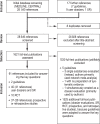Patients With Multiple Myeloma or Monoclonal Gammopathy of Undetermined Significance
- PMID: 35314026
- PMCID: PMC9358349
- DOI: 10.3238/arztebl.m2022.0149
Patients With Multiple Myeloma or Monoclonal Gammopathy of Undetermined Significance
Abstract
Background: Multiple myeloma (MM) is a malignant plasma-cell disease that arises on the basis of a so-called monoclonal gammopathy of undetermined significance (MGUS). The median age at disease onset is over 70. In Germany, there are approximately eight new cases per 100 000 inhabitants per year, or about 6000 new patients nationwide each year.
Methods: To prepare this clinical practice guideline, a systematic literature review was carried out in medical databases (MEDLINE, CENTRAL), guideline databases (GIN), and the search portal of the German Institute for Quality and Efficiency in Health Care (IQWiG). The recommendations to be issued were based on two international guidelines, 40 dossier evaluations and systematic reviews, 10 randomized controlled trials, and 37 observational studies and finalized in a structured consensus process.
Results: Because of its prognostic relevance, the use of the International Staging System (ISS) is recommended to stage MM and related plasma-cell neoplasms. When symptomatic MM is diagnosed, it is recommended to determine the extent of skeletal involvement by whole-body computed tomography. The indications for treatment shall be determined on the basis of the SLiMCRAB criteria; in all patients with MM it is recommended to include the biological (rather than chronological) age in the decisionmaking process. In suitable patients, it is recommended that initial treatment includes high-dose therapy, followed by main - tenance treatment. Even without high-dose treatment, a median progression-free survival of more than three years can be achieved with combination therapies. For the treatment of relapse, combinations of three drugs are more effective than doublet regimens with a median progression-free survival ranging from 10 to 45 months, depending on the study and prior therapy. Following anti-myeloma therapy, it is recommended to promptly offer physical exercise adapted to individual abilities to all patients who have the potential for rehabilitation, so that their quality of life can be sustained and improved.
Conclusion: This new clinical practice guideline addresses, in particular, the modalities of care that can be offered in addition to systemic antineoplastic therapy. In view of the significant recent advances in the treatment of myeloma, affected patients' quality of life now largely depends on optimized interdisciplinary care.
Figures





References
-
- RKI. Vol. 13. Berlin: 2021. Multiples Myelom. Krebs in Deutschland für 2017/2018. Zentrum für Krebsregisterdaten und Gesellschaft der epidemiologischen Krebsregister in Deutschland e. V; pp. 138–141.
-
- Leitlinienprogramm Onkologie (Deutsche Krebsgesellschaft, AWMF) Diagnostik, Therapie und Nachsorge für Patienten mit monoklonaler Gammopathie unklarer Signifikanz (MGUS) oder Multiplem Myelom. 2022; Leitlinienreport 1.01, AWMF Registernummer: 018/035OL. www.leitlinienprogramm-onkologie.de/fileadmin/user_upload/Downloads/Leit... (last accessed on 23 February 2022)
Publication types
MeSH terms
LinkOut - more resources
Full Text Sources
Medical

